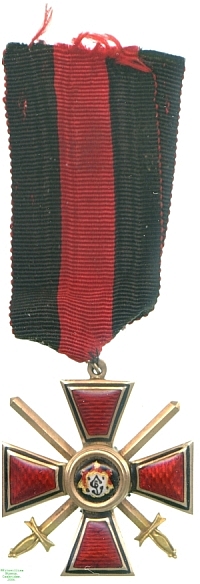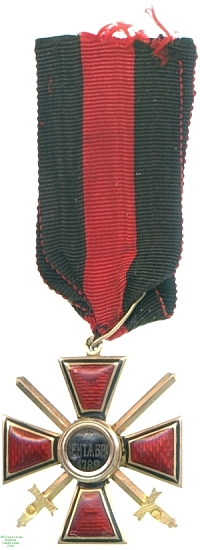Badge of the Order of St Vladimir, 3rd Class, awarded to 2nd Lt. John Mitchell 1919

Obverse, a black enamelled central disc bearing a crowned red and ermine mantle with the monogram of St. Vladimir, on a red enamelled cross pattée with black enamelled borders and crossed swords between the arms
|

Reverse, a black enamelled central disc containing the inscription, on a red enamelled cross pattée with black enamelled borders, and crossed swords between the arms
|
<- Previous | Next ->
Back to gallery page
Badge of the Order of St Vladimir, 3rd Class, 1919
The Order of St Vladimir was founded by Catherine II (the Great), Empress of Russia, in 1782, in four classes depending on the rank of the recipient. It was intended to be awarded for the saving of ten lives from fire or water. This was later interpreted more broadly as an award that could be given for acts of military defence.
During the collapse of Tsarist Russia in the Revolution of 1917, a Provisional Government was briefly formed to represent the interests of government against the Bolshevik factions of the new order, and then various regional governments were formed in their wake, but what came to be classed as White Russian (as opposed to Red) resistance was eventually (by the end of 1918) crystallised around the Siberian Regional Government led by the Vice-Admiral Aleksandr Kolchak.
Despite the death of not only Tsar Nicholas II in 1917 but Grand Duke Michael his notional successor in 1918, effectively ending the Romanov royal line in whose name they were given, Kolchak's government maintained the issue of royal decorations and orders until the final collapse of the White Russian resistance in 1921, by which time Kolchak, perhaps their most capable military leader, had been made to resign.
This Badge is not named, but its provenance as part of a larger group tells us that it was awarded to 2nd Lieutenant John Mitchell, of the Royal Air Force contingent that served in South Russia in support of British forces embroiled in the unsuccessful defence of White Russia, with whose other medals Lester Watson acquired it. The medal may have been awarded for the same exploit which won Mitchell his Distinguished Flying Cross (and nearly a Victoria Cross), although Mitchell only (!) saved three lives on that occasion. His more aggressive endeavours in this campaign also won him decorations from Britain and White Russia alike.
Although the catalogue of the Watson Collection considers Mitchell's awards as its Group 7, the medals of that group are not physically attached and so have been treated separately here. Nonetheless it was as a group that Lester Watson purchased them, from the London dealers Baldwin in 1928.

